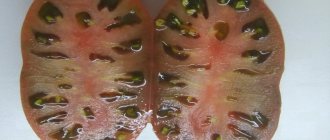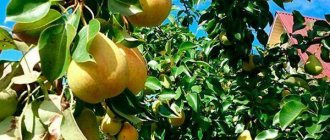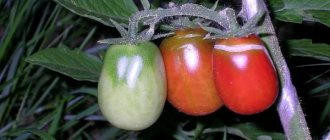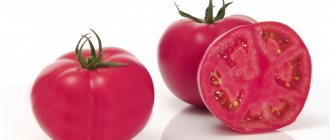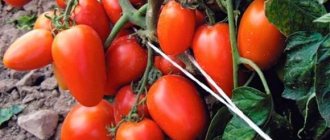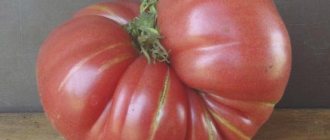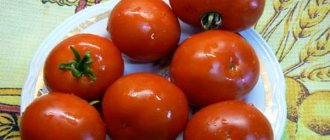Description of the plant
This variety was registered only in 2015, but the tomato managed to gain considerable popularity and positive reviews from gardeners.
| Stem | The tomato bush has a strong, powerful stem that is not too leafy. This is very good, because the sun's rays reach the fruits unhindered, there is no dampness or shade that contributes to the development of fungal diseases. | |
| Sheet | The leaves are light green, not hairy, and medium in size. | |
| Fruit | The first brush is tied after the 7th leaf. And then - after every second. There are up to 6 fruits on the hands, which sit firmly on the stalks and do not fall off even with strong ripening. | |
| Root system | The plant is characterized by a well-developed, powerful root system, capable of providing nutrients for a solid harvest. | |
| Ripening period | The variety is very early - already on the 85th day after sowing you can taste the first tomato from the garden. | |
| Productivity | Despite early ripening, the plant is very prolific - from 1 sq. m. harvest up to 1 kg of tomatoes. | |
Attention! The variety exhibits its best qualities only under conditions of proper agricultural technology. This variety is recommended to be grown in greenhouses.
Tomato Big Mom: variety description and characteristics
Tomato Big Mommy: photo of variety
Before giving preference to one variety or another, you need to read its description. And also with advantages. The Big Mom tomato is an early ripening variety. Large, bright red tomatoes usually ripen in 90 days. Determinate variety. This means that the height of his growth is limited. And, as a rule, it stops after the appearance of the fifth flower-fruit cluster. After this, all efforts are aimed at ripening the crop. The height of the bush is usually about 60 cm. If the soil is very fertile and you regularly apply fertilizer, the bush can grow a little larger. But it will never grow above one meter.
Big Mama tomatoes are very large, meaty, with the perfect balance of sweetness and acidity. The autumn taste is rich and pleasant. The weight of the smallest ones is from 150 g. And large fruits can weigh up to 0.4 kg. There are seven or eight seed chambers inside. But at the same time there are few seeds themselves. In a greenhouse you can get up to 10 kg of tomatoes from one square meter. Outside, the yield of the Big Momma tomato is not so high. And the tomatoes themselves are smaller.
Fruit characteristics
The fruits are dome-shaped with a pronounced nose. There is no pronounced ribbing, it is barely visible. Sometimes tomatoes take on a round shape.
The weight of the fetus can reach up to 400-500 grams. Tomatoes are especially good because they have thin skin, which is appreciated by lovers of fresh salads.
Interesting! Even ripe fruits with thin skin do not lose their shape during transportation.
The color of a ripe tomato is bright red, while unripe tomatoes are usually green or brownish in color. The fruits have excellent taste and aroma.
Harvesting and application
Tomatoes ripen 85-90 days after germination. The weight of the fruit varies from the bottom to the top of the bush: the lower ones up to 400 g, the upper ones - 150-200 g.
Ramson (lat. Allium ursinum) - beneficial properties, harvesting methods, use in cooking and folk medicine
They are consumed fresh: in salads, sandwiches. The variety is suitable for making juices, purees, sauces and snacks. Small fruits can be preserved whole. The thick skin prevents the tomatoes from cracking, making them suitable for transportation. The keeping quality is high; according to farmers, the fruits are stored until late autumn.
Important! Picked unripe, tomatoes take several weeks to arrive in a dark, dry place.
Vivid advantages of the variety
The good thing about the breeders’ new product is that scientists have tried to take into account the wishes of gardeners and rid the future vegetable of unnecessary qualities.
The variety has many advantages:
- resists many diseases;
- produces high yields with simple care;
- the fruits are large;
- with a large mass, tomatoes do not crack;
- rapid ripening of tomatoes with large sizes;
- the variety is resistant to heat and cold;
- high taste qualities;
- universal use - suitable for canning, fresh salads, sauces.
Heat treatment practically does not change the taste of the fruit.
Tomatoes Big Mommy on video
If you grew Big Mom tomatoes, please write whether you liked them or not. What was the yield and taste of the fruits like under your climatic conditions? How do you rate the disease resistance of this tomato? Briefly describe the advantages and disadvantages of the variety in your opinion. If possible, attach a photo of the entire bush or individual fruits you grew to your comment. Thank you!
Your reviews of the Big Momma tomato and additions to the description will help many gardeners evaluate this variety more objectively and decide whether it is worth planting or not.
Planting a tomato
Like all tomatoes, the “Big Momma” variety must go through several stages when growing - seedlings, picking, planting in beds.
Sowing seeds for seedlings
All varieties are planted as seedlings 50-60 days before transplanting into open ground or a greenhouse. The “Big Momma” variety is too early to ripen, so its seeds can be planted 7-10 days later than regular ones.
To prevent young plants from being disturbed by pests, the soil placed in the boxes must be steamed and spilled with hot water and a dark-colored solution of potassium permanganate.
Before sowing, seeds can be soaked in Epin or Zircon. After soaking, the seeds are sown in the soil to a depth of 1.5-2 cm. Boxes with tomato seedlings should be placed on a sunny windowsill and the plantings should be provided with a high temperature (25 degrees).
Shoots appear 5-7 days after planting. After germination, the temperature should be lowered, then the young vegetation will not stretch.
Picking
When 3-5 leaves appear on young sprouts, the seedlings need to be picked - planted in separate cups. Picking is done so that young plants develop a good root system so that they have enough sunlight and nutrients.
Picking is done simply - pour soil into a pot or plastic cup, make a hole in it, then take a young plant out of the box with a knife or fork, slightly trim the longest root and plant the tomato in the hole. The root is trimmed so that more other roots grow and a powerful root system is formed.
Attention! It is convenient to keep pots or cups with picked seedlings in drawers. It is convenient to take pots in boxes for hardening into the greenhouse or turn the plants over with the other side facing the sun.
Planting seedlings in beds
When the soil in greenhouses or open ground has warmed up sufficiently and the threat of frost has passed, the seedlings are planted in the ground.
To ensure painless planting, the plants need to be hardened off 10-14 days before planting. Hardening is not difficult - you just need to take the boxes into the greenhouse, onto the windowsill in the apartment, when the weather permits. First, take it out for 20 minutes, then increase the time.
The holes are placed at a distance of 50-60 cm.
After planting, immediately tie up the bush. The variety grows rapidly; an untied bush can quickly break.
Tomato yield Big Mom
Due to the large size of the fruits, the yield of the Big Mom tomato variety is high - at least 10 kg of ripe tomatoes are harvested from each square of area. But it should be noted that in open ground fruiting is lower than in greenhouses.
Growing and care
Caring for seedlings is not difficult. Every gardener knows that tomatoes require:
- Timely watering - usually once a week. Experienced gardeners irrigate tomatoes, focusing on the condition of the soil. Often the middle of summer is simply scorching, then the tomatoes need to be watered every day. The end of summer is often damp and cold, and then tomatoes are rarely watered even in a greenhouse. You need to water carefully, without soaking the leaves.
- After watering, loosening is usually carried out. It is convenient to combine loosening with weeding - in this case, the weeds are easily pulled out by their roots.
- Much attention should be paid to pinching - bush formation. The bush of the “Big Momma” variety is grown in 2 trunks, which means that all other shoots are mercilessly removed - they will suck the juices from the plant and shade the bush, which adversely affects growth and development.
- Feeding. To help a tomato produce a large harvest, it needs to be fed. The first fertilizing (organic) is carried out 10 days after planting. The second feeding is applied after 10 days.
- Protection from diseases and pests. The variety resists diseases well, so if the right conditions are created, tomatoes will not require chemical intervention. It is necessary to carefully examine the plants for yellowing of the leaves, the appearance of other symptoms of diseases, and pests.
How to grow tomatoes
The seedlings are transplanted to a permanent place at the age of 55-60 days. In cold regions - only in film shelters. The soil temperature should reach +13... +15 °C, and the air temperature - +12 °C and at least +5 °C. Frosts will either destroy fragile plants or slow down the development of tomatoes for 15-20 days.
Landing
The site for future planting of tomatoes is chosen in advance. It is important that the year before this, no plants of the nightshade family grew on it, but cucumbers, zucchini, and dill are good predecessors and neighbors for tomatoes of any variety.
A day before planting seedlings, the soil is disinfected with a strong solution of potassium permanganate or boiling water. For Big Momma, choose a planting pattern of 40 x 50 cm.
Care
Tomatoes are transplanted in a greenhouse in early to mid-May; in warm regions, it is acceptable at the end of April. By this time, the seedlings have already grown from five to nine pairs of leaves, and plant growth reaches 20-25 cm. It is recommended to plant tomatoes of this variety in open ground only in warm regions of the country - a month later than under cover. In central Russia, when growing outside a greenhouse, it is recommended to cover tomatoes with agricultural material for the first 15-20 days.
Business idea – Production of furniture from natural wood
A week after transshipment, the bushes are tied up. Water as the soil dries, strictly at the root, avoiding moisture getting on the stem and leaves. Water for irrigation is pre-settled and heated in the sun. After each watering, loosen the soil and remove weeds. At the moment of fruit formation, plants need abundant soil moisture, but as soon as the green fruits begin to turn red, watering is reduced.
Fertilizers are applied every 10-12 days, alternating complex and mineral. Before flowering, tomatoes are fed with nitrogen fertilizers, and during the flowering phase - with potassium fertilizers. Foliar feeding will help increase productivity: wood ash, boric acid solution. After applying fertilizer, the tomatoes are watered abundantly.
Gradually, the lower leaves are plucked from the bush so that they do not take away useful substances from the ovaries and do not contribute to the spread of infections and harmful insects.
Bushes form 2-3 stems. The photo below shows the diagram: main shoot + 1-2 stepsons. The remaining branches are removed. Stepson removal is carried out once a week, removing no more than two stepsons at a time. As the bush develops, each branch is tied up so that the heavy fruits do not break or knock the plant to the ground.
Advice. Experienced summer residents advise removing a pair of unripe fruits from each inflorescence. In this case, those remaining on the branch will receive more nutrients and grow larger.
Features of cultivation and possible difficulties
As noted by farmers who have already tried to grow Big Mom tomatoes, there are no difficulties or peculiarities in growing this variety.
Diseases and pests
On the packaging, manufacturers indicate that tomatoes are highly resistant to fungal diseases and pests.
To prevent and treat fungal diseases, plantings are treated with Fitosporin. Brown olive spot (cladosporiosis) is treated with copper-containing preparations, for example, “Bordeaux mixture” or “Barrier,” and blossom end rot is treated with calcium nitrate spraying.
Advice. In regions with short, cool or rainy summers, late blight affects tomatoes under the film. Whey is used to prevent the disease. Immediately after transplanting the seedlings into the ground, the bushes are sprayed with whey (with a fat content of no more than 1% - otherwise you can burn the leaves). The procedure is repeated every 10 days. To prevent blossom end rot, the soil is fertilized with eggshells and onion peels.
Tomatoes are attacked by harmful insects. For aphids and thrips they use the drug "Bison", for the Colorado potato beetle - "Prestige", for whiteflies - "Confidor", for spider mites - "Apollo".
Pros and cons
The main advantages of the Big Momma tomato variety include:
- the variety has good yield;
- large fruit;
- ripe fruits are not prone to cracking;
- early ripening of tomatoes;
- the possibility of growing the variety in garden beds and in greenhouse conditions;
- versatility of the harvested crop;
- Ripe tomatoes tolerate transportation well over different distances and have good shelf life.
But the variety also has its disadvantages:
- due to the large size of the fruit, Big Momma’s shoots need to be tied up;
- constant stepsoning should be carried out;
- bushes need to be formed into 2 or 3 stems.

